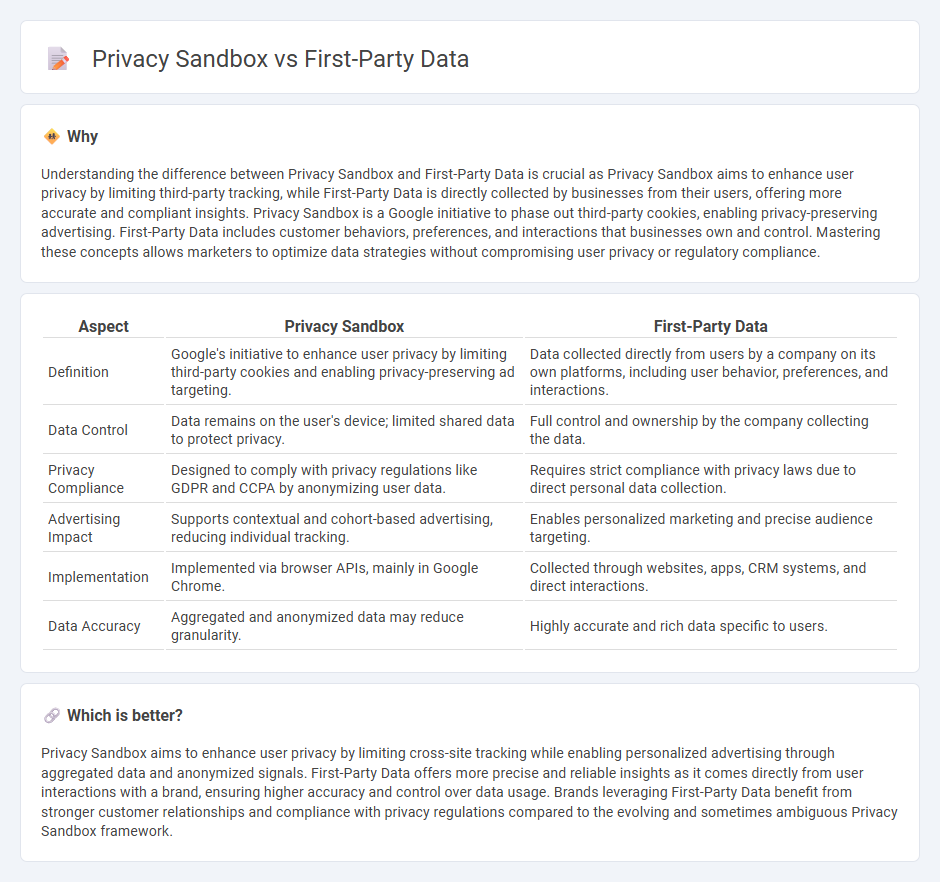
Privacy Sandbox enhances user privacy by enabling targeted advertising without third-party cookies, focusing on aggregated and anonymized data within the browser environment. First-party data involves information collected directly from users by a website or app, offering high accuracy and control for personalized marketing strategies. Explore how these approaches shape the future of digital advertising and data privacy.
Why it is important
Understanding the difference between Privacy Sandbox and First-Party Data is crucial as Privacy Sandbox aims to enhance user privacy by limiting third-party tracking, while First-Party Data is directly collected by businesses from their users, offering more accurate and compliant insights. Privacy Sandbox is a Google initiative to phase out third-party cookies, enabling privacy-preserving advertising. First-Party Data includes customer behaviors, preferences, and interactions that businesses own and control. Mastering these concepts allows marketers to optimize data strategies without compromising user privacy or regulatory compliance.
Comparison Table
| Aspect | Privacy Sandbox | First-Party Data |
|---|---|---|
| Definition | Google's initiative to enhance user privacy by limiting third-party cookies and enabling privacy-preserving ad targeting. | Data collected directly from users by a company on its own platforms, including user behavior, preferences, and interactions. |
| Data Control | Data remains on the user's device; limited shared data to protect privacy. | Full control and ownership by the company collecting the data. |
| Privacy Compliance | Designed to comply with privacy regulations like GDPR and CCPA by anonymizing user data. | Requires strict compliance with privacy laws due to direct personal data collection. |
| Advertising Impact | Supports contextual and cohort-based advertising, reducing individual tracking. | Enables personalized marketing and precise audience targeting. |
| Implementation | Implemented via browser APIs, mainly in Google Chrome. | Collected through websites, apps, CRM systems, and direct interactions. |
| Data Accuracy | Aggregated and anonymized data may reduce granularity. | Highly accurate and rich data specific to users. |
Which is better?
Privacy Sandbox aims to enhance user privacy by limiting cross-site tracking while enabling personalized advertising through aggregated data and anonymized signals. First-Party Data offers more precise and reliable insights as it comes directly from user interactions with a brand, ensuring higher accuracy and control over data usage. Brands leveraging First-Party Data benefit from stronger customer relationships and compliance with privacy regulations compared to the evolving and sometimes ambiguous Privacy Sandbox framework.
Connection
Privacy Sandbox and First-Party Data are connected through their shared goal of enhancing user privacy while enabling targeted advertising. Privacy Sandbox introduces privacy-preserving APIs that limit third-party cookie tracking, pushing advertisers to rely more on first-party data collected directly from user interactions. Leveraging first-party data within the Privacy Sandbox framework allows businesses to deliver personalized experiences without compromising user privacy or data security.
Key Terms
User Consent
First-party data is collected directly from users with their explicit consent, ensuring compliance with privacy regulations and enhancing personalized marketing strategies. The Privacy Sandbox framework seeks to protect user privacy by limiting third-party cookies and promoting anonymized data-sharing methods that respect user consent preferences. Explore how these evolving standards impact user trust and data-driven advertising techniques.
Data Ownership
First-party data provides businesses full ownership and control over customer information collected directly, ensuring compliant and personalized marketing strategies. Privacy Sandbox, introduced by Google, aims to enhance user privacy by limiting data sharing while enabling targeted advertising through aggregated, anonymized signals rather than individual identifiers. Explore the evolving landscape of data ownership and privacy by learning more about these critical concepts.
Targeted Advertising
First-party data enables advertisers to reach audiences through directly collected customer information, enhancing personalized targeting and measurement accuracy. Privacy Sandbox introduces privacy-preserving APIs by Google to phase out third-party cookies, balancing ad relevance with user data protection. Explore deeper insights on how these approaches shape the future of targeted advertising.
Source and External Links
What Is First-Party Data (+ Second-Party and Third-Party Data)? - First-party data is information your company collects directly from your audience through interactions like website visits, social media engagement, surveys, and customer feedback, often stored in a CRM or customer data platform.
What is first-party data and how does it benefit your marketing - First-party data is collected directly from customers via company-owned channels, providing high accuracy and reliability for personalized marketing and stronger customer relationships while complying with privacy laws.
What is first-, second-, third- and zero-party data? - Epsilon US - First-party data gives businesses a direct view of customer behaviors and preferences, allowing enhanced personalization, future-proof marketing without reliance on cookies, and opportunities for cross-sell and upsell by leveraging purchase history.
 dowidth.com
dowidth.com